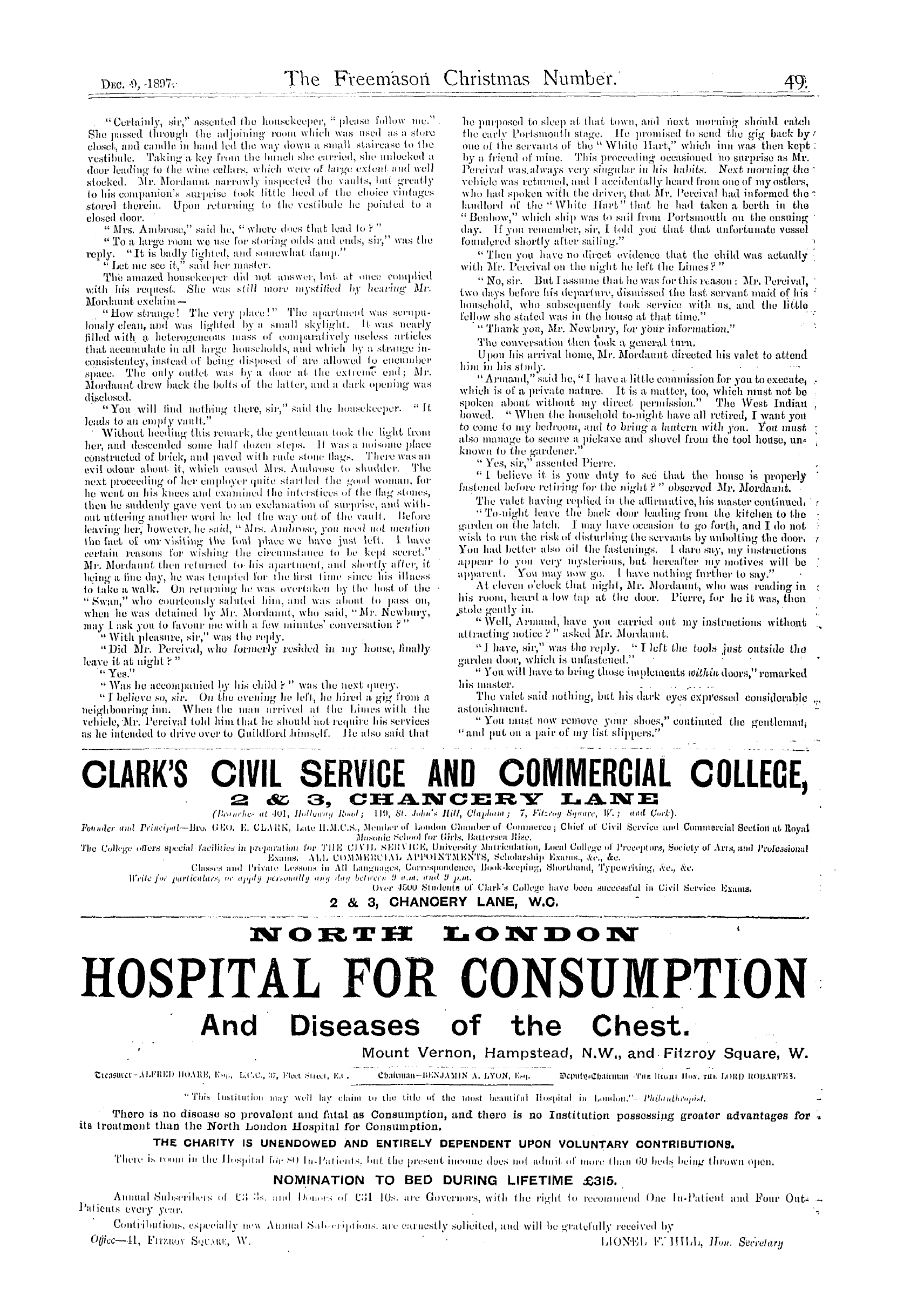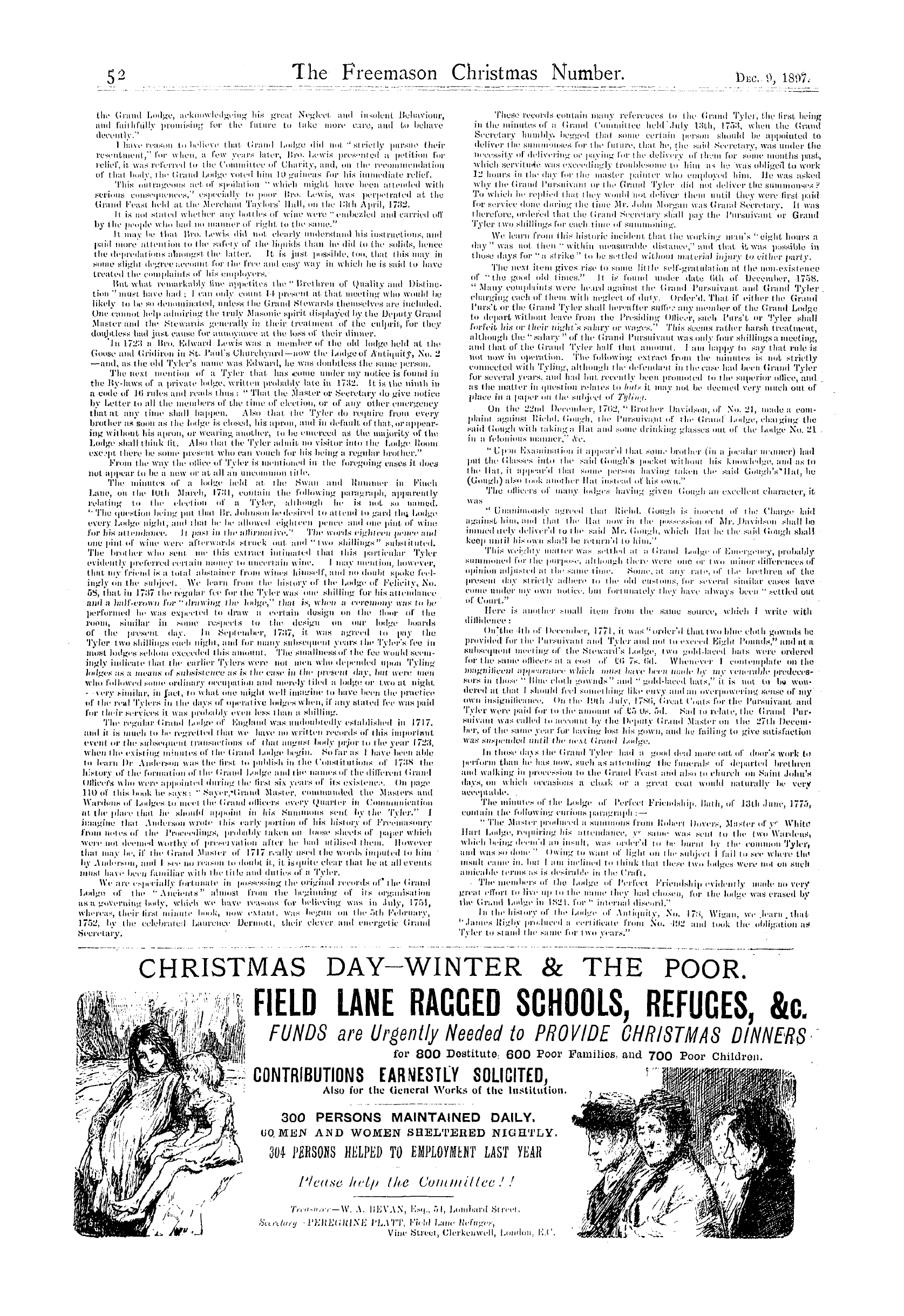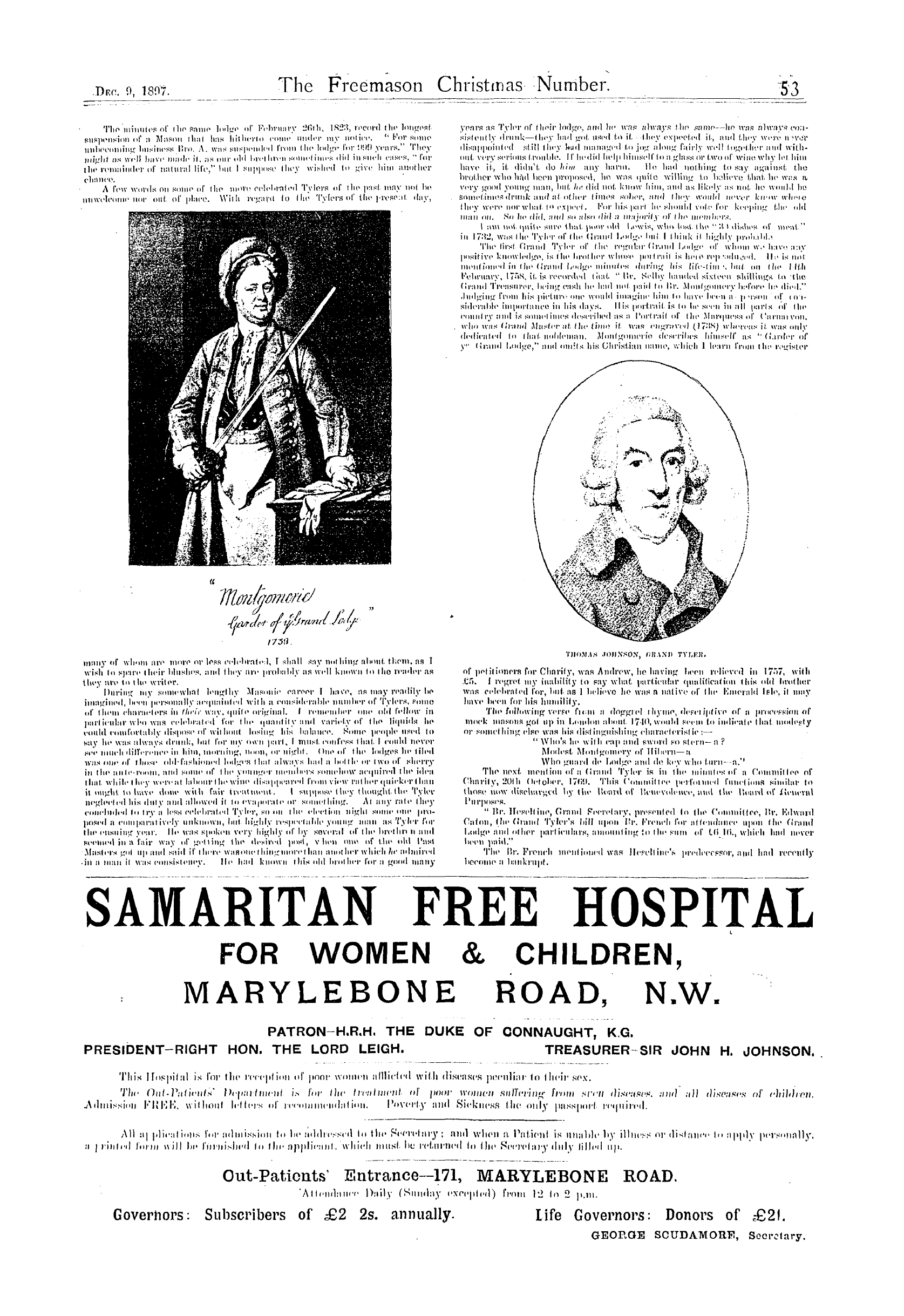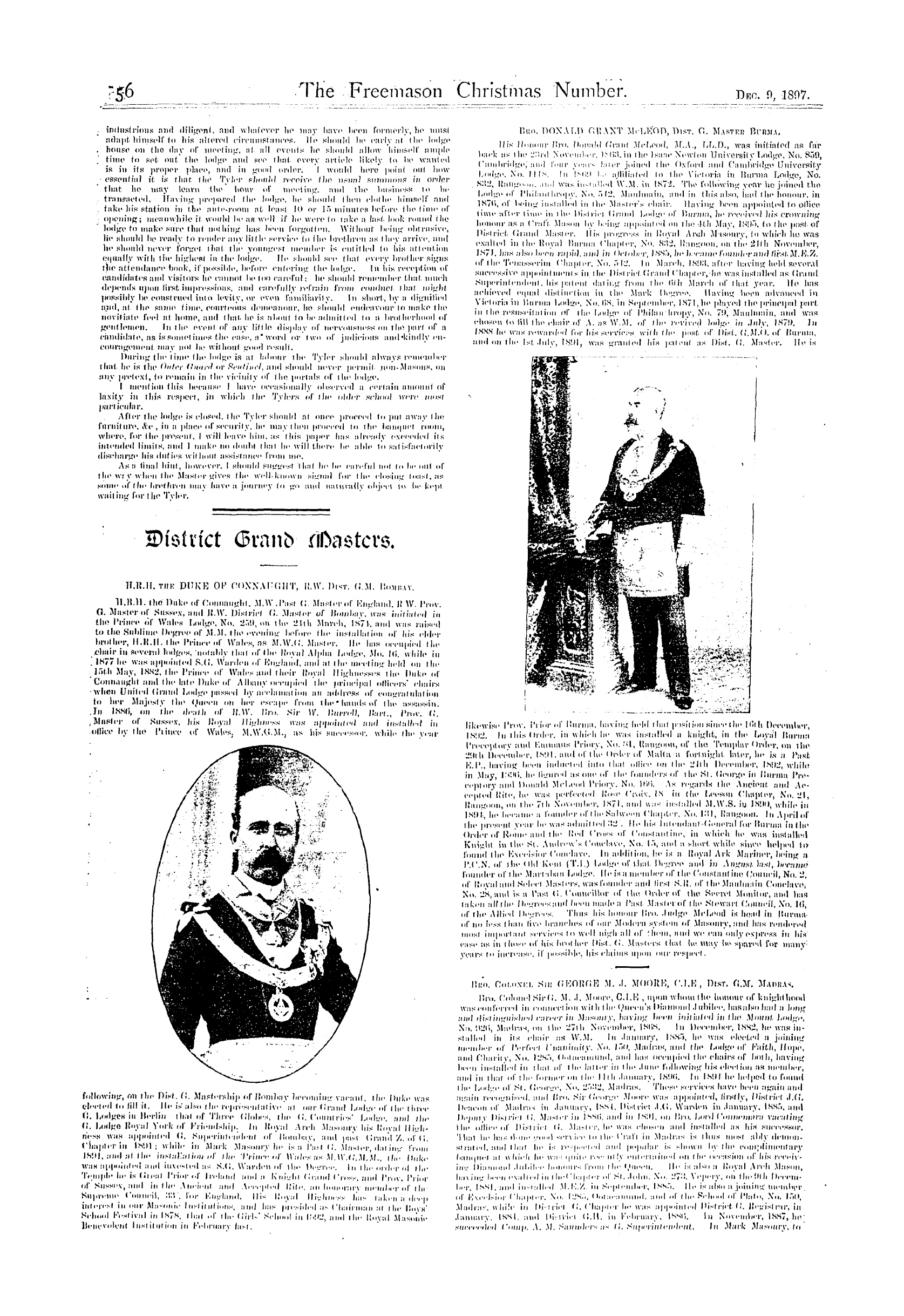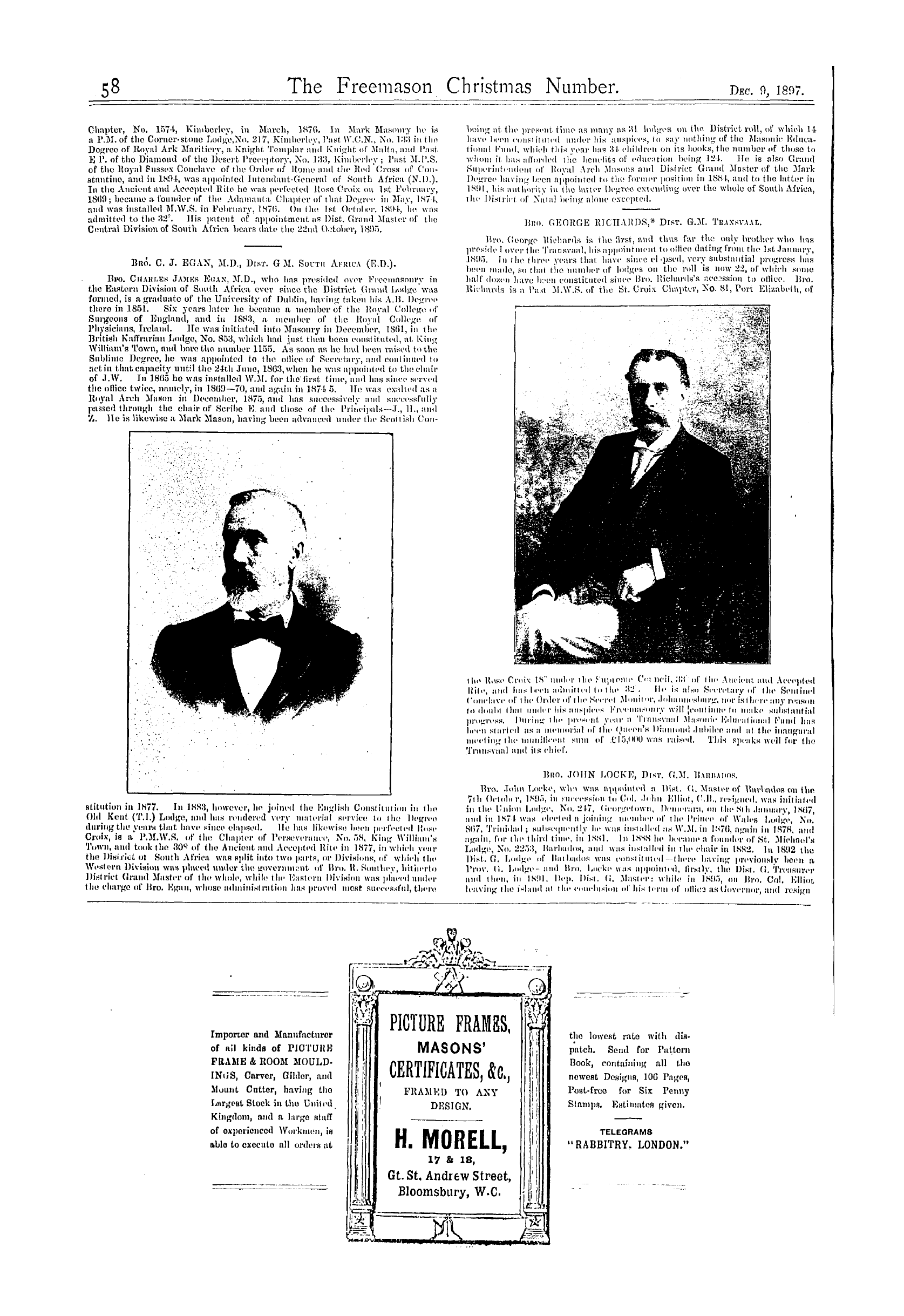-
Articles/Ads
Article Freemasonry in 1897. ← Page 10 of 10 Article The Craft and its Orphans in the Eighteenth Century. Page 1 of 1 Article The Craft and its Orphans in the Eighteenth Century. Page 1 of 1
Note: This text has been automatically extracted via Optical Character Recognition (OCR) software.
Freemasonry In 1897.
New Zealand does not appear to have made progress . The Grand Lodge of Victoria has sustained a heavy loss by the death of Bro . Sir W . J . Clarke , Mart ., Past and Pro G . Master , than whom it will be difficult to mention one who has rendered more signal service lo Freemasonry . He was at the head of the three . Constitutions in Victoria before the foundation of its
United Grand Lodge , and when that body was formed he naturally was elected its lirst M . W . G . M ., foregoing the office in favour of Mro . Lord Brassey on his lordshi p ' s appointment as Governor , and accepting the post of Pro Grand Master . In Queensland great progress has been made under Bro .
Aug . C . Gregory , C . M . G ., who is still , alter 35 years service , the District Grand Master , while in Western Australia there has been a large increase in the number of lodges , of which there are now 22 on the roll . In short , to whatever quarter we
turn , wc find the Craft increasing and multi p lying , and becoming stronger than ever by the influence it exercises , and we can do no more than congratulate the brethren in the Colonies , &( ' ., ecc , on the increase of prosperity they have enjoyed during the year 18 97 . May our reports for future years be as gratifying !
The Craft And Its Orphans In The Eighteenth Century.
The Craft and its Orphans in the Eighteenth Century .
J 3 v W . J . CHETWODE GTUWLEY , LL . D ,, D . C . L ., P . ti . D ., and G . See . Inst . Ireland . p ^~ -p g | 5 * g | ) 1 ] , ] Ancient Landmarks of Freemasonry , like nil other W / ^ K ^ C ^^\ landmarks , material or symbolical , can only preserve
l ( ((^ r * l ) i I 'Feir stability , when they reach down ( o sure foumlu-|\ w ^ W / I ] tion . s . When ( he philosophic student unearths ( he [ tt ^ fe ^^ S . 1 underlying rock on which our Ancient Landmarks rest , he finds our sure foundations in the tri ple dogma of the Fatherhood of God , the Brotherhood of Alan , iinil the Life to come . All laws , customs and methods that obtain amongst us and ultimately do not find foothold on this basis , are thereby earmarked
as conventions and conveniences , 110 way partaking ot the nature ol Ancient Landmarks . Many corollaries How from these twin fundamental propositions , " and the greatest of these is Charily . " What more logical or more obvious deduction can be conceived than the care of the Fatherless children of our Brethren r
Tin-: E . NCLLSII Gnn . s SCHOOL . Our good Brethren of the lust century were thus inevitably led lo the foundation of schools for ( he orphan children of their les . s foriiniato Fellows of the Craft . First of theso . schemes to come to maturity in the British Isles was the Givls' School , projected in 1788
by Bro . the Chevalier Ruspini , an Italian b y birth , an Englishman hy choice , and a Freemason by heart . lie was fortunate enough to secure for ( he School , almost from the very beginning , the patronage of tho Duke of Cumberland , Grand Master of the ( Irand Lodge of ( he Muilc-i 11 s , ( he more aristocratic of tho two lirand Lodges that then divided ( he allegiance of ( he Brotherhood in England .
At ( lie Quarterl y Communication held in February , I 7 IMI , the Grand Lodge of the Moderns extended . formal recognition lo ( he School , which hud already testified its grateful sense of the patronage of their Royal Hignnesses , the Duke and Duchess of Cumberland , by adopting tho somewhat clumsy title of "The Royal Cumberland Free Masons' School . "
Tim IIIISII Giiii . s SCHOOL . Incited by the success , and convinced of ( he merits of tin charitable organisation thus incorporated by llie Grand Lodge of fin Moderns , ( he Freemasons who held wilh Grand Lodges of the Antients started similar orirunisalious on bolli sides of ( lie Channel .
In Dublin , " Sundry Brethren " were emboldened by flic . success ol the London School to form themselves into a modest " Societ y for ( In Schooling of the Orphan Children of Distressed Masons . " Hy I 7 ! l . " i their scheme hud so grown upon their hands' ( hut they fell justified in presenting si petition to the ( bund Lodge of Ireland for its
approbation . They were received with open arms . I he sanction was at once grunted , and u ( ( he next Staled C inimical ion , February , 17 ! Mi , a vote of thanks was passed to " the worthy Ihcthreii with whom the idea originated . " We can thankfully thai from ( hat day lo this the prosperity of the Masonic Female Orphan School of Ireland has kept , pace with that of ils English sister Institution .
The lii . sli chronicle would lie incomplete without a mention ol the Masonic Female Orphan Asylum of Minister . Foremost of all provincial cities in the British Isles lo recognise ( he claims of llie Orphan , Cork was only a few years behind Dublin in establishing un asylum , whicli ultimatel y merged , about GO years ago , into the Meti-oiolilan School .
The Craft And Its Orphans In The Eighteenth Century.
Tin : ENGLISH BOYS' SCHOOL . Lastly , in 1798 , certain of thc English Brethren , who held under the Grand Lodge of the Antients , devised a plan "for clothing and educating the Sons of indigent Free Masons . " This nlan .
cordiallvadopted by the Grand Lodge of the Antients , has developed into the "Royal Masonic Institution for Boys , " the inevitable complement and fair rival in good works of the Girls' School , which had the advantage of 10 years' start .
Here ends the catalogue of the Orphan Charities founded by the Freemasons of tho United Kingdom during the eighteenth century . The story of the English foundations has been excellentl y told by the facile pen of Bro . G . blizard Abbott in thc admirable series of Handbooks hc has devoted to our Charities .
The story ot the Irish Charities still awaits a competent chronicler .
EARLY TENTATIVE EI-TUKTS . Admittedly , this catalogue sounds meagre , and comes very late in the century . The Grand Lodges of England and Ireland had been in full swing for nearl y two-thirds of a century before they look charge of the Orphans of Distressed Brethren . The duty so to do
follows so naturally from the princi ples of Freemasonry that the most superficial observer must confess to a feeling of surprise at ( he late origin of these Charitable Institutions . The success that attended them , when once started , must beget a suspicion that they werc but the conversion into conscious deed of what had long beeii familiar to the Craft in unconscious thought .
BKO . JOII . N IJOAMAN ' PLAN . Accordingly , we lind that , both in England and in Ireland , ( here had been mooted schemes that , for one reason or another , failed to recommend themselves ( o ( he favourable consideration of the Brethren . The earlier and the more important of these . schemes was that of Bro . John Boaman , 173 S-9 .
This nnilcrtaknig has never hud justice done to it , and wc trust cur renders will bear with us while we endeavour to give a sketch of the kindly-meant plan that failed , more than a 150 years ago , to win the . support of the Grand Lodge of England . Every student of the early annals of Grand Lodge is familiar with
the brief paragraph in the Booh of Condi ! idiom , edited b y John Entick , M . A ., 1756 , which announces under date 81 st January , 17 ' 58- ! l , the rejection of " a scheme for the placing out Mason ' s Sons
Apprentices . " The paragraph is not such as would draw special attention , unil our Historians , even those dealing with the History ol fhe Educational Charities , have naturally passed it oyer , forthe most purl , withwr . t comment .
The scheme , however , is not fairl y described in the paragraph , and wus set out with a thoroughness and simplicity that deserved a better fate .
The original schedule presented to Grand Lodge is preserved in the Bodleian Library at Oxford , and forms a part of the famous collection bequeathed to the University b y Dr . Richard Rawlinson , P . M . of the Lodge once held at the Bricklayer .- ; ' Arms , Barbican . The document will be found in the folio volume catalogued as Hawlinson MS ., C , 136 .
Tin : GiiAxn Lonui :, . " 1 ST JANUAUV , 173 S-9 . The foregoing schedule was evidentl y prepared for circulation af ( he Quarterly Communication of Grand Lodge held at the " Devil ' s Tavern within Temple Bar " on Wednesday , 31 st January , l 73 S- !> . The meeiing was trul y representative of the London-Brethren . The
al tendance was the largest recorded up to thut time in the annals of Grand Lodge . The Masters and Wardens of !) 2 Lodges were present , a number exceeding b y one half the number of Lodges represented at ( he preceding or at tlio subsequent Communication . The Marquis of Carnavon was in the chair , attended by Dr . William Graeme , as
his Deputy . The Grand Wardens of the year , Lord George Graham , [ Old Captain Andrew Robinson were in their places ; supporting them were no les . s than four Past Grand Masters , George Payne , Esq ., Dr , Desguliers , the Earl of London , and Earl of Darnley ; three Past Grand Wardens , Mr . Jacob Lumbal ) , carpenter , the relic of the
operative days , Martin O'Connor , Esq ., the friend of the International Grand Master , Lord Kingston , and Martin Clare , ( he author of the weightiest Defence of Masonry ever published , together with the late Deputy Grand Muster , Thomas Bat . son , Esq . Above all ( hero were
rulers of the Crait that worked beyond the seas , representative Brethren from the great Western Continent , Robert Tomlinson , Ksq ., Provincial Grand Master of New England , and John Hammerton , Esq ., Provincial Grand Master of Carolina .
In this assemblage , Brother . lohn Boaman brought forward lib plan lo provide for the children of destitute Freemasons . The Uuvh 0 / (' oitslihilitiiis curtly describes the result : — "A Scheme was proposed for Ihe placing out Mason ' s Sole , Apprentices , but after long Debute the Proposal wus rejected , as it would loo much all ' eet the Fund of Charity . "
The truth is , Ihe plan came he I ore ils lime The popular mind in England was not prepared for organized beneficence towards children . Good people ( here were , and kind people within and without the Fraternity , who busied themselves about the welfare of children . Mul these were individuals , working at ( he close of an age of tumultuous reaction , which hud discarded the old methods , and
Note: This text has been automatically extracted via Optical Character Recognition (OCR) software.
Freemasonry In 1897.
New Zealand does not appear to have made progress . The Grand Lodge of Victoria has sustained a heavy loss by the death of Bro . Sir W . J . Clarke , Mart ., Past and Pro G . Master , than whom it will be difficult to mention one who has rendered more signal service lo Freemasonry . He was at the head of the three . Constitutions in Victoria before the foundation of its
United Grand Lodge , and when that body was formed he naturally was elected its lirst M . W . G . M ., foregoing the office in favour of Mro . Lord Brassey on his lordshi p ' s appointment as Governor , and accepting the post of Pro Grand Master . In Queensland great progress has been made under Bro .
Aug . C . Gregory , C . M . G ., who is still , alter 35 years service , the District Grand Master , while in Western Australia there has been a large increase in the number of lodges , of which there are now 22 on the roll . In short , to whatever quarter we
turn , wc find the Craft increasing and multi p lying , and becoming stronger than ever by the influence it exercises , and we can do no more than congratulate the brethren in the Colonies , &( ' ., ecc , on the increase of prosperity they have enjoyed during the year 18 97 . May our reports for future years be as gratifying !
The Craft And Its Orphans In The Eighteenth Century.
The Craft and its Orphans in the Eighteenth Century .
J 3 v W . J . CHETWODE GTUWLEY , LL . D ,, D . C . L ., P . ti . D ., and G . See . Inst . Ireland . p ^~ -p g | 5 * g | ) 1 ] , ] Ancient Landmarks of Freemasonry , like nil other W / ^ K ^ C ^^\ landmarks , material or symbolical , can only preserve
l ( ((^ r * l ) i I 'Feir stability , when they reach down ( o sure foumlu-|\ w ^ W / I ] tion . s . When ( he philosophic student unearths ( he [ tt ^ fe ^^ S . 1 underlying rock on which our Ancient Landmarks rest , he finds our sure foundations in the tri ple dogma of the Fatherhood of God , the Brotherhood of Alan , iinil the Life to come . All laws , customs and methods that obtain amongst us and ultimately do not find foothold on this basis , are thereby earmarked
as conventions and conveniences , 110 way partaking ot the nature ol Ancient Landmarks . Many corollaries How from these twin fundamental propositions , " and the greatest of these is Charily . " What more logical or more obvious deduction can be conceived than the care of the Fatherless children of our Brethren r
Tin-: E . NCLLSII Gnn . s SCHOOL . Our good Brethren of the lust century were thus inevitably led lo the foundation of schools for ( he orphan children of their les . s foriiniato Fellows of the Craft . First of theso . schemes to come to maturity in the British Isles was the Givls' School , projected in 1788
by Bro . the Chevalier Ruspini , an Italian b y birth , an Englishman hy choice , and a Freemason by heart . lie was fortunate enough to secure for ( he School , almost from the very beginning , the patronage of tho Duke of Cumberland , Grand Master of the ( Irand Lodge of ( he Muilc-i 11 s , ( he more aristocratic of tho two lirand Lodges that then divided ( he allegiance of ( he Brotherhood in England .
At ( lie Quarterl y Communication held in February , I 7 IMI , the Grand Lodge of the Moderns extended . formal recognition lo ( he School , which hud already testified its grateful sense of the patronage of their Royal Hignnesses , the Duke and Duchess of Cumberland , by adopting tho somewhat clumsy title of "The Royal Cumberland Free Masons' School . "
Tim IIIISII Giiii . s SCHOOL . Incited by the success , and convinced of ( he merits of tin charitable organisation thus incorporated by llie Grand Lodge of fin Moderns , ( he Freemasons who held wilh Grand Lodges of the Antients started similar orirunisalious on bolli sides of ( lie Channel .
In Dublin , " Sundry Brethren " were emboldened by flic . success ol the London School to form themselves into a modest " Societ y for ( In Schooling of the Orphan Children of Distressed Masons . " Hy I 7 ! l . " i their scheme hud so grown upon their hands' ( hut they fell justified in presenting si petition to the ( bund Lodge of Ireland for its
approbation . They were received with open arms . I he sanction was at once grunted , and u ( ( he next Staled C inimical ion , February , 17 ! Mi , a vote of thanks was passed to " the worthy Ihcthreii with whom the idea originated . " We can thankfully thai from ( hat day lo this the prosperity of the Masonic Female Orphan School of Ireland has kept , pace with that of ils English sister Institution .
The lii . sli chronicle would lie incomplete without a mention ol the Masonic Female Orphan Asylum of Minister . Foremost of all provincial cities in the British Isles lo recognise ( he claims of llie Orphan , Cork was only a few years behind Dublin in establishing un asylum , whicli ultimatel y merged , about GO years ago , into the Meti-oiolilan School .
The Craft And Its Orphans In The Eighteenth Century.
Tin : ENGLISH BOYS' SCHOOL . Lastly , in 1798 , certain of thc English Brethren , who held under the Grand Lodge of the Antients , devised a plan "for clothing and educating the Sons of indigent Free Masons . " This nlan .
cordiallvadopted by the Grand Lodge of the Antients , has developed into the "Royal Masonic Institution for Boys , " the inevitable complement and fair rival in good works of the Girls' School , which had the advantage of 10 years' start .
Here ends the catalogue of the Orphan Charities founded by the Freemasons of tho United Kingdom during the eighteenth century . The story of the English foundations has been excellentl y told by the facile pen of Bro . G . blizard Abbott in thc admirable series of Handbooks hc has devoted to our Charities .
The story ot the Irish Charities still awaits a competent chronicler .
EARLY TENTATIVE EI-TUKTS . Admittedly , this catalogue sounds meagre , and comes very late in the century . The Grand Lodges of England and Ireland had been in full swing for nearl y two-thirds of a century before they look charge of the Orphans of Distressed Brethren . The duty so to do
follows so naturally from the princi ples of Freemasonry that the most superficial observer must confess to a feeling of surprise at ( he late origin of these Charitable Institutions . The success that attended them , when once started , must beget a suspicion that they werc but the conversion into conscious deed of what had long beeii familiar to the Craft in unconscious thought .
BKO . JOII . N IJOAMAN ' PLAN . Accordingly , we lind that , both in England and in Ireland , ( here had been mooted schemes that , for one reason or another , failed to recommend themselves ( o ( he favourable consideration of the Brethren . The earlier and the more important of these . schemes was that of Bro . John Boaman , 173 S-9 .
This nnilcrtaknig has never hud justice done to it , and wc trust cur renders will bear with us while we endeavour to give a sketch of the kindly-meant plan that failed , more than a 150 years ago , to win the . support of the Grand Lodge of England . Every student of the early annals of Grand Lodge is familiar with
the brief paragraph in the Booh of Condi ! idiom , edited b y John Entick , M . A ., 1756 , which announces under date 81 st January , 17 ' 58- ! l , the rejection of " a scheme for the placing out Mason ' s Sons
Apprentices . " The paragraph is not such as would draw special attention , unil our Historians , even those dealing with the History ol fhe Educational Charities , have naturally passed it oyer , forthe most purl , withwr . t comment .
The scheme , however , is not fairl y described in the paragraph , and wus set out with a thoroughness and simplicity that deserved a better fate .
The original schedule presented to Grand Lodge is preserved in the Bodleian Library at Oxford , and forms a part of the famous collection bequeathed to the University b y Dr . Richard Rawlinson , P . M . of the Lodge once held at the Bricklayer .- ; ' Arms , Barbican . The document will be found in the folio volume catalogued as Hawlinson MS ., C , 136 .
Tin : GiiAxn Lonui :, . " 1 ST JANUAUV , 173 S-9 . The foregoing schedule was evidentl y prepared for circulation af ( he Quarterly Communication of Grand Lodge held at the " Devil ' s Tavern within Temple Bar " on Wednesday , 31 st January , l 73 S- !> . The meeiing was trul y representative of the London-Brethren . The
al tendance was the largest recorded up to thut time in the annals of Grand Lodge . The Masters and Wardens of !) 2 Lodges were present , a number exceeding b y one half the number of Lodges represented at ( he preceding or at tlio subsequent Communication . The Marquis of Carnavon was in the chair , attended by Dr . William Graeme , as
his Deputy . The Grand Wardens of the year , Lord George Graham , [ Old Captain Andrew Robinson were in their places ; supporting them were no les . s than four Past Grand Masters , George Payne , Esq ., Dr , Desguliers , the Earl of London , and Earl of Darnley ; three Past Grand Wardens , Mr . Jacob Lumbal ) , carpenter , the relic of the
operative days , Martin O'Connor , Esq ., the friend of the International Grand Master , Lord Kingston , and Martin Clare , ( he author of the weightiest Defence of Masonry ever published , together with the late Deputy Grand Muster , Thomas Bat . son , Esq . Above all ( hero were
rulers of the Crait that worked beyond the seas , representative Brethren from the great Western Continent , Robert Tomlinson , Ksq ., Provincial Grand Master of New England , and John Hammerton , Esq ., Provincial Grand Master of Carolina .
In this assemblage , Brother . lohn Boaman brought forward lib plan lo provide for the children of destitute Freemasons . The Uuvh 0 / (' oitslihilitiiis curtly describes the result : — "A Scheme was proposed for Ihe placing out Mason ' s Sole , Apprentices , but after long Debute the Proposal wus rejected , as it would loo much all ' eet the Fund of Charity . "
The truth is , Ihe plan came he I ore ils lime The popular mind in England was not prepared for organized beneficence towards children . Good people ( here were , and kind people within and without the Fraternity , who busied themselves about the welfare of children . Mul these were individuals , working at ( he close of an age of tumultuous reaction , which hud discarded the old methods , and















































